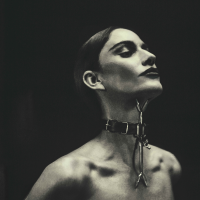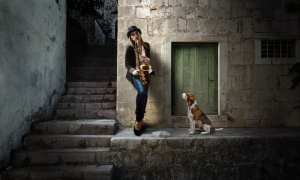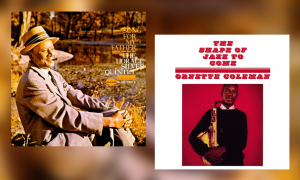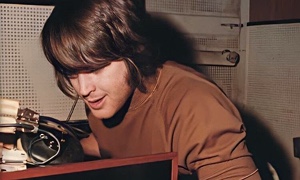Home » Jazz Articles » Building a Jazz Library » Jazz Masterpieces: 1956-1965
Jazz Masterpieces: 1956-1965
After surveying our editors, we compromised on this short "master" list. For listeners keen on what the definitive truth was at a certain point in jazz's history, this one's for you.
If you're just stepping into the jazz world, be assured that these recording signposts mark high points, turning points, and moments of sheer genius. In other words, required listening.
After all... it's all we can do to shorten the ranks of great recordings in order to distill a few that we think can stand alone. Feel free to judge for yourself. We're confident that you'll enjoy these selections.
 Art Blakey & The Jazz Messengers
Art Blakey & The Jazz MessengersMoanin' (1958)
Jazz's most explosive drummer debuted his third version of the Jazz Messengers with this instant hard-bop classic. It's way too funky in here, thanks to compositions and performances by Benny Golson, Lee Morgan, and Bobby Timmons (who contributed the famous title track).
 Dave Brubeck
Dave BrubeckTime Out (1959)
What was conceived by pianist Brubeck as an adventure into unusual time signatures ended up one of the most successful records in jazz history, due in large part to its beautiful melodies and the mesmerizing alto work of Paul Desmond.
 Ornette Coleman
Ornette ColemanThe Shape of Jazz to Come (1959)
After four decades, this disc remains true to its title. Saxophonist Ornette Coleman solidified his group in 1959 to the working quartet recorded here. They broke convention and provided a major stepping stone on the road to free jazz.
 John Coltrane
John ColtraneLove Supreme (1964)
One of Coltrane's most spiritually moving recordings, this disc has been popular among devotees and neophytes alike. It's a heart-felt celebration of divine love, with equal measures of devotion and exploration.
 Miles Davis
Miles DavisKind of Blue (1959)
The best-selling jazz recording of the era (and a perfect introduction for the jazz newbie), Kind of Blue helped introduce a new sound for jazz. Working from relatively simple structures, the musicians here lay out wonderfully lyrical extended improvisations.
 Eric Dolphy
Eric DolphyOut to Lunch (1964)
Eric Dolphy was always a big fan of bird calls, and much of his playing here reflects that natural sonority. This disc transports a relatively straight-ahead group into adventurous, inventive territory—with dramatically successful results.
 Bill Evans
Bill EvansWaltz for Debby & Live at the Village Vanguard (1961)
The laid-back character of Bill Evans's piano playing here masks a serenely beautiful touch and wonderfully innovative ideas. His inhumanly intuitive interactions with bassist Scott LaFaro remain legendary. This is the best piano trio music ever recorded (and it's all live).
 Herbie Hancock
Herbie HancockMaiden Voyage (1965)
Pianist Herbie Hancock's best record adopts a nautical angle, with gentle waves of sound surrounding strong, forward-sailing melodies. Maiden Voyage relies upon subtlety, but it features wonderful group interaction and showcases some of Hancock's finest playing.
 Thelonious Monk
Thelonious MonkBrilliant Corners (1956)
Quirky yet rigorously logical, Brilliant Corners is a triumph of composition and performance, a set heavy on Monk originals with Rollins, Roach and Pettiford along for the swing. Even its title describes Monk's angular genius.
 Oliver Nelson
Oliver NelsonBlues & The Abstract Truth (1961)
Some of Nelson's best work—as a composer, arranger, AND saxophonist—features his large ensemble soulfully tight-roping arrangement and improvisation. A genuine masterpiece that has inspired musicians and arrangers for decades.
 Sonny Rollins
Sonny RollinsSaxophone Colossus (1956)
Not just one of Rollins' great moments—one of the great "monster" jazz sessions of all time, and, in "St. Thomas," one the first crossroads between Jazz and the Caribbean.
 Horace Silver
Horace SilverSong for My Father (1963)
One of the first hard bop albums and also one of the greatest, and not just from that title track (honored in "Rikki Don't Lose That Number") but also his classic "Lonely Woman."
 Jimmy Smith
Jimmy SmithThe Sermon (1958)
A foreshadowing of Smith's awesome Chicken Shack and Midnight Special, and defining moment of organ jazz. Smith, Lee Morgan and Curtis Fuller testify on the side-long title track.
Tags
PREVIOUS / NEXT
Support All About Jazz
 All About Jazz has been a pillar of jazz since 1995, championing it as an art form and, more importantly, supporting the musicians who make it. Our enduring commitment has made "AAJ" one of the most culturally important websites of its kind, read by hundreds of thousands of fans, musicians and industry figures every month.
All About Jazz has been a pillar of jazz since 1995, championing it as an art form and, more importantly, supporting the musicians who make it. Our enduring commitment has made "AAJ" one of the most culturally important websites of its kind, read by hundreds of thousands of fans, musicians and industry figures every month.
























